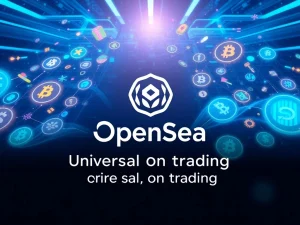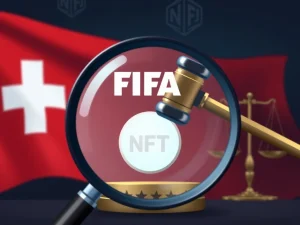Takashi Murakami NFTs: A Revolutionary Leap for Digital Art on Base Blockchain

The worlds of high art and cutting-edge technology are converging in an exciting new chapter. Imagine owning a piece of a legendary artist’s work, not as a physical painting, but as a verifiable digital asset. This is precisely what’s happening with the launch of the highly anticipated Takashi Murakami NFTs, specifically the “108 Flowers Revised” collection, set to bloom on the Base blockchain. This isn’t just another NFT drop; it’s a pivotal moment that merges Murakami’s decades-long influence in contemporary art with the transformative power of Web3 innovation.
Takashi Murakami NFTs: A New Canvas for Iconic Art
Takashi Murakami, a name synonymous with vibrant, whimsical, and often thought-provoking art, is making a significant splash in the digital realm. Known for his distinctive “Superflat” aesthetic—a style that blurs the lines between high art and pop culture, and flattens perspective—Murakami has collaborated with global brands like Louis Vuitton and Supreme, cementing his status as a cultural icon. Now, his iconic imagery, particularly the beloved ‘Flowers’ motif, is being reinterpreted for the blockchain.
The “108 Flowers Revised” collection isn’t merely a digital replica; it builds upon his established works and introduces unique rarity mechanics, promising potential utility within emerging digital trading card ecosystems. These Takashi Murakami NFTs are positioned not just as speculative assets but as verifiable digital artifacts, offering a new dimension to his creative legacy. For collectors, this represents an opportunity to own a piece of art history in a verifiable, immutable format, blending Murakami’s artistic innovation with the transformative potential of Web3.
Why the Base Blockchain is a Game-Changer for Digital Art
The choice of the Base blockchain for this groundbreaking collection is a strategic masterstroke. Developed by Coinbase, Base is a Layer 2 solution built on Ethereum, designed to address some of the most common hurdles in the NFT space. Here’s why Base is a crucial element for this project’s success:
- Accessibility: Base significantly mitigates the high gas fees often associated with Ethereum-based NFT transactions. This makes participation feasible for a much wider audience, democratizing art ownership, especially for those new to blockchain.
- Scalability: As a Layer 2 network, Base offers faster and more efficient transactions, crucial for high-demand minting events like Murakami’s.
- Security & Trust: Leveraging Coinbase’s robust infrastructure, Base enhances trust in the platform’s security and operational reliability. This integration offers a streamlined experience, reducing friction for first-time users and attracting Murakami’s existing fanbase into the Web3 space.
This alignment with Base underscores a strategic focus on user-friendliness, aiming to broaden the appeal of digital art to both traditional collectors and crypto-native audiences. It’s a move that recognizes the importance of lowering barriers to entry for mainstream adoption.
The Expanding Universe of Web3 Innovation in Art
Murakami’s foray into NFTs on Base is a powerful testament to the growing legitimacy of Web3 innovation within the art world. This isn’t just about selling digital pictures; it’s about redefining ownership, provenance, and distribution for creative works. Web3 technologies, powered by blockchain, enable:
- Verifiable Ownership: NFTs provide immutable proof of ownership, a critical aspect often lacking in traditional digital content.
- Direct Creator-to-Collector Models: Artists can connect directly with their audience, bypassing traditional intermediaries and potentially retaining a larger share of sales.
- New Forms of Utility: Beyond simple collectibility, NFTs can offer access to exclusive communities, digital experiences, or even serve as components in metaverse environments.
This project validates NFTs as a legitimate extension of traditional art, potentially encouraging institutional adoption and inspiring other creators to explore digital formats. It’s a clear signal that Web3 innovation is not just a passing trend but a foundational shift in how we create, own, and interact with art.
Navigating the NFT Market: Opportunities and Considerations
The launch of such a high-profile collection inevitably brings excitement and scrutiny to the NFT market. For collectors, the opportunity to own a piece of Murakami’s digital legacy is significant. However, it’s crucial to approach the market with a clear understanding of its dynamics:
| Opportunity | Consideration / Challenge |
|---|---|
| Cultural Significance: Own a piece bridging traditional art and Web3. | Market Volatility: Secondary market valuations can fluctuate rapidly. |
| Potential Utility: Future integration into digital ecosystems. | High Demand: Risk of overwhelming minting capacity during launch. |
| Enhanced Accessibility: Lower fees and user-friendly platform (Base). | Security Risks: Phishing scams, wallet vulnerabilities. |
| Community & Exclusivity: Access to artist-centric digital communities. | Technical Readiness: Need to prepare crypto (ETH bridged to Base) and wallet. |
While the prospect of acquiring a Murakami NFT is enticing, users are advised to prioritize security, prepare their cryptocurrency (likely ETH bridged to Base), and ensure their wallet is ready well ahead of the July 31st minting event. Understanding the nuances of the NFT market is key to a successful and secure collecting experience.
Beyond Collectibles: The Future of Digital Art
The cultural impact of the Murakami NFT initiative extends far beyond mere transactional aspects. By embracing blockchain, Murakami reinforces the idea that digital art can coexist with physical art in the cultural canon. His NFTs serve as a vital bridge between legacy art institutions and decentralized communities, emphasizing the role of technology in preserving creative expression and fostering new forms of engagement.
This project is a beacon for the future, inspiring other established artists and institutions to explore the boundless possibilities of Web3. It highlights how digital assets can offer new avenues for artists to monetize their work, engage with fans, and build sustainable creative careers in an increasingly digital world. The “108 Flowers Revised” collection isn’t just art; it’s a statement about the evolving nature of creativity and ownership in the 21st century.
Preparing for the Mint: A Collector’s Checklist
If you’re looking to participate in the Takashi Murakami NFTs mint, here are some actionable insights to ensure you’re ready:
- Set up a Crypto Wallet: Use a reputable wallet like MetaMask or Coinbase Wallet. Ensure it’s secure and you’ve backed up your seed phrase.
- Fund Your Wallet: You’ll need Ethereum (ETH) to cover the mint price and transaction fees.
- Bridge ETH to Base: Since the mint is on Base, you’ll need to bridge your ETH from the Ethereum mainnet to the Base network. Use a reliable bridge for this process.
- Stay Informed: Follow official announcements from Murakami’s team and the Base blockchain for exact minting details, time, and contract addresses. Beware of scams.
- Understand the Mechanics: Familiarize yourself with the minting process, including any potential allowlists or public sale details.
Conclusion
The launch of Takashi Murakami’s “108 Flowers Revised” NFTs on the Base blockchain represents a monumental step forward for both the art world and the Web3 ecosystem. It’s a powerful fusion of artistic genius and technological innovation, setting a new precedent for how iconic art can thrive in the digital age. By making his work accessible on a scalable and user-friendly platform, Murakami is not only expanding his artistic legacy but also ushering in a new era for digital art ownership and cultural engagement. This project is a vivid reminder of Web3’s potential to democratize, innovate, and inspire.
Frequently Asked Questions (FAQs)
What are Takashi Murakami’s “108 Flowers Revised” NFTs?
The “108 Flowers Revised” is a collection of non-fungible tokens (NFTs) by renowned contemporary artist Takashi Murakami. These digital collectibles are derived from his iconic “Flowers” motif and trading card series, translated into blockchain-based assets with unique rarity mechanics.
Why did Murakami choose the Base blockchain for this NFT collection?
Murakami chose the Base blockchain, a Layer 2 solution developed by Coinbase, for its strategic advantages. Base offers significantly lower transaction fees compared to the Ethereum mainnet, improved scalability, and enhanced security through its integration with Coinbase’s infrastructure. This choice aims to make the NFTs more accessible and user-friendly for a broader audience.
What are the benefits of owning a Takashi Murakami NFT?
Owning a Takashi Murakami NFT offers several benefits, including verifiable digital ownership of a piece by a celebrated artist, potential future utility within digital ecosystems, participation in a new form of art collecting, and the opportunity to be part of a project that bridges traditional art with Web3 innovation.
What should collectors consider before participating in the NFT market?
Collectors should be aware of market volatility, which can affect secondary market valuations. They should also prepare for high demand during minting events, ensure their cryptocurrency wallets are secure, and understand the process of bridging funds (e.g., ETH) to the Base blockchain. Always verify information from official sources to avoid scams.
How does this project impact the broader digital art world?
Takashi Murakami’s entry into the NFT space significantly legitimizes digital art as a medium for artistic expression and cultural preservation. It encourages institutional adoption of blockchain technology in art, inspires other established artists to explore digital formats, and reinforces the idea that digital art can coexist with physical art in the cultural canon, bridging legacy art institutions with decentralized communities.








